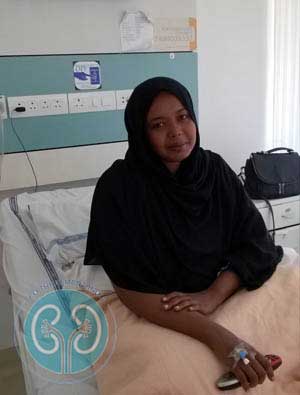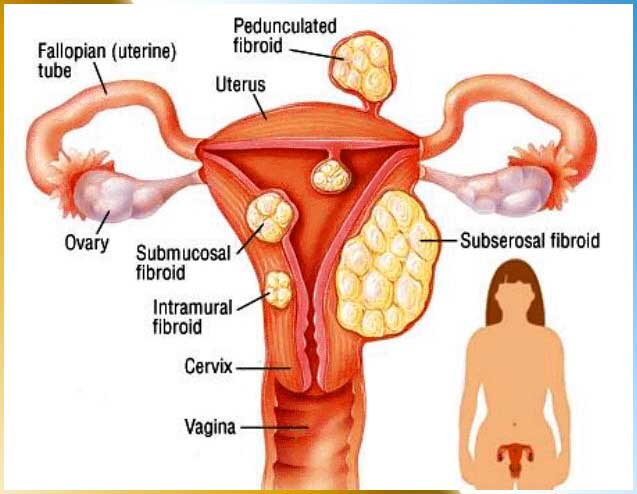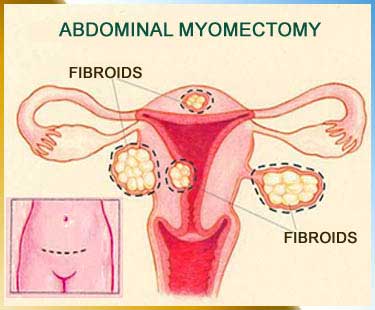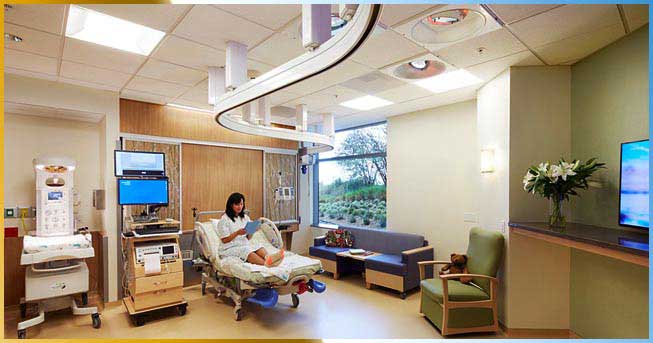Fibroid Removal (Myomectomy) Surgery in India |
 |
Patient Testimonial

Hi! I am Mrs. Ambeva Edward from Kenya. I work at a Travel Agency and I am 36 years old. I live in Nigeria with my husband. For years I had suffered with fibroids. As the fibroids grew, my complications related to fibroids such as infertility, miscarriages, severe anemia, thyroid, back pain, sciatic nerve, sleeplessness, severe PMS and debilitating pain controlled every aspect of my life. I tried everything including diet, exercise, herbal remedies, yoga etc. all to no avail. My life was becoming bad to worse. At one point, I was hospitalized for a blood transfusion. The treatment for Uterine Fibroids in Kenya was not that developed and also the doctors charged enormously. But I found EDTreatment India through internet, that helped me in my Uterine fibroid treatment in India. I highly recommend EDTreatment India Consultants. Every penny spent was worth it. I am very thankful to EDTreatment India Consultants who introduced, managed and coordinated my medical trip to India. All of the medical attention I received has exceeded my expectations.
Thank you
Mrs. Ambeva Edward
What are Fibroids?
 When it comes to defining a fibroid, it is nothing but a non-cancerous tumor, which originates from the smooth muscle layer and the associated connective tissue of the uterus. The fibroids are generally among the benign tumors and are found in females and generally found during the middle and later stage of reproductive years. Though a majority of fibroids are asymptomatic, they can be seen growing and causing a very heavy and painful menstruation period along with giving you a very painful sexual intercourse experience along with issues like urinary frequency and urgency and some fibroids can be even seen hampering the pregnancy phase. The Uterine sarcoma is the usual issue, which can be called as a cancer of the uterine muscle, however, this condition is extremely rare, occurring in less than one patient per thousand who have surgery for fibroids. As per reports, around 80 percent of women with fibroids never have to under any surgery as these can be fixed with non-surgical procedures. When it comes to defining a fibroid, it is nothing but a non-cancerous tumor, which originates from the smooth muscle layer and the associated connective tissue of the uterus. The fibroids are generally among the benign tumors and are found in females and generally found during the middle and later stage of reproductive years. Though a majority of fibroids are asymptomatic, they can be seen growing and causing a very heavy and painful menstruation period along with giving you a very painful sexual intercourse experience along with issues like urinary frequency and urgency and some fibroids can be even seen hampering the pregnancy phase. The Uterine sarcoma is the usual issue, which can be called as a cancer of the uterine muscle, however, this condition is extremely rare, occurring in less than one patient per thousand who have surgery for fibroids. As per reports, around 80 percent of women with fibroids never have to under any surgery as these can be fixed with non-surgical procedures.
What are the causes?
When it comes to discussing the causes of fibroids, there is still not any. In fact, it is still not clear why fibroids are seen getting developed but there are a number of factors, which can influence their formation and are indicated as under:
-
Hormones: The estrogen and progesterone are the hormones, which are produced by the ovaries. They cause the uterine lining in order to regenerate during each and every menstrual cycle and these can stimulate the growth of fibroids.
-
Family History: The fibroids can be seen running inside the family. If your mother, sister, or grandmother is seen having the history of this condition, you may develop it as well.
-
Pregnancy: Now talking about the pregnancy, it simply is seen boosting up the production of estrogen and progesterone inside your body. The fibroids can be seen developing and growing rapidly while you are pregnant.
Severity of Fibroids - Kidney Damage:
The severity of the fibroids is often reported rare. One can find very rarely the fibroids may growing abnormally and they are seen getting pressed against the ureters, slowing or stopping even the flow of urine out of the kidney. If urine fails to come out freely from the kidney, the pressure is seen building up inside the kidney and the damages are seen getting caused to the kidney. This process is often very slow and usually shows no symptoms at all. If a patient is being closely followed by a doctor, it is very really very unlikely to see any kind of severe damage that can be seen occurring inside the kidneys. On examination, one can find the doctor even feeling if the fibroids are too near the ureters. There are some action that are supposed to be advised, before the slow process of damage to the kidneys is seen getting started.
Hysterectomy
If you talk about this surgery, this can be done through the vaginal opening or via the abdomin and recovery time of the patient would depend upon which way you go. It is often said that the recovery time for a vaginal hysterectomy can be a few weeks but for a procedure like abdominal hysterectomy it can even take around twice the time it requires in a normal case in fact this can even toll to a couple months. After the surgery of hysterectomy, the patient should often try to remain like a sedentary as possible and absolutely “no heavy lifting.” The patient may even be required to consume special foods and take even a certain vitamin and mineral supplements. Most importantly, this surgery will also bringing out the end of childbearing and it is known to bring on early menopause.
Myomectomy
 If you talk about the surgery called the myomectomy, it is surgically similar to a hysterectomy but it is often meant to remove the “easy to get to” fibroids. Generally this surgery is carried out through the abdomin and the uterus wall is then reconstructed after removal of the fibroids. One of the key benefit over the hysterectomy is that the patient can continue with childbearing issue but the patient may even redevelop the fibroids in the future. If this is the case then the patient will once again have to go for the surgery. The patient may also need to understand that there is a good amount of possibility that some of the fibroids will be seen getting missed away during the myomectomy and they will end up continuing to grow. The recovery time is usually around for four weeks if done via the abdomen but if it is carried out via the vagina you will be looking at just a few hours. If you talk about the surgery called the myomectomy, it is surgically similar to a hysterectomy but it is often meant to remove the “easy to get to” fibroids. Generally this surgery is carried out through the abdomin and the uterus wall is then reconstructed after removal of the fibroids. One of the key benefit over the hysterectomy is that the patient can continue with childbearing issue but the patient may even redevelop the fibroids in the future. If this is the case then the patient will once again have to go for the surgery. The patient may also need to understand that there is a good amount of possibility that some of the fibroids will be seen getting missed away during the myomectomy and they will end up continuing to grow. The recovery time is usually around for four weeks if done via the abdomen but if it is carried out via the vagina you will be looking at just a few hours.
Uterine Fibroid Embolization
This surgery is also called as uterine artery embolization, which is considered as the most invasive procedure and desirable as compared to the hysterectomy and myomectomy. As you dig in deep into this procedure, you can find the catheter being placed inside the artery, which is supplying the fibroid and then blocking away the blood flow. With little to no blood supplying to the fibroid, it will end up shrinking in size. Since this is very less intensive than the procedures like hysterectomy and myomectomy surgery procedures, the required recovery time is found out to be around a week’s time. Generally the patient has to stay for not less than a day in the hospital after the surgery.
Focused Ultrasound
With this procedure one can see the doctor combining the use of an MRI and ultrasound waves together to give nothing but the liberty from this ailment. As individuals, the MRI and ultrasound have been around for a long time and then they are being combined in order to help in treating the ailment called fibroids. The 3-dimensional viewing capabilities which come along with the MRI offer the surgeon with a better view of the fibroids and the uterus along with the intense ultrasound sound waves that can be used with the pin-point accuracy in order to heat up and thus kill off the fibroids cells. This treatment technique is usually carried out on an outpatient basis and the recovery time is a few hours.
Procedures for Fibroid Surgery
The fibroid surgery comes as a last resort to everyone. For this you need to have an understanding of a number of methods of fibroids surgery and the things are expected with each of them. The statistics simply showcase the fact that 25 percent of all women between the age group of 30 to 50 years are seen suffering with fibroids so it is very much common. But make sure you do not count on the same as it is not the only way to treat uterine fibroids. The surgery should be the last resort andthere are natural techniques and methods, which are proven to work and they may just work for you. They are certainly a worthy thing to try when you consider the end results of surgery.
Cost of Fibroid treatment in India
When it comes to the cost of fibroid treatment in India, it is considered to be among the most affordable option. The following cost comparison with India and other countries will give the idea how affordable are the Indian hospitals:
Medical Treatment |
India |
United States |
Hysterectomy |
3,300 |
30,000 |
Myomectomy |
3,600 |
28,000 |
Uterine Artery Embolization |
3,300 |
35,000 |
Hence you can easily make out the difference between the Indian cost and the Cost of the US for various procedures meant for treating fibroids.

Advance Treatment Options for Fibroid Surgery
When it comes to the advanced treatment options for Fibroid surgery, there are few, which are discussed below, let’s check them out as under:
Embolization: This procedure simply helps in shrinkingthe fibroids with the help of cutting off the blood supply. It is then guided by an X-ray image and the doctor threads a small catheter via a small incision inside the groin in the main arteries, which end up supplying the blood to the uterus. The doctor then injects particles of inert plastic via the catheter in order to block these blood vessels. The uterus remains unaffected without having any damage in it. The procedure hardly takes about an hour and is carried out under the influence of local or general anesthesia. The woman must lie flat on her back for six hours in order to stop the bleeding.
Laparoscopic Surgery: The other advanced option to get rid of fibroids can be carried out using a laparoscope, which is nothing but a pencil thin surgical telescope which is very much similar to a hysteroscope. The surgeon is then seen inserting the laparoscope and tiny surgical instruments via one or more small incision inside the abdomen. If the fibroids are seen small and easy to reach, the surgeon is seen making an incision over the uterus and then removes them. This is known as a laparoscopic myomectomy. The surgery requires no overnight stay at the hospital, which means women going for this surgery can return home the very same day.
Hysteroscopic Resection: This advanced procedure meant to treat the fibroids are seen using a hysteroscope, which is basically a thin telescope and it is inserted through the cervix. It helps the surgeon to see inside the uterus. The surgeon is then seen removing the fibroids with the help pf laser or via an electrical knife, wire, or probe. No incision is made with this procedure. The procedure can be carried out with the help of local or general anesthesia. The woman may stay overnight in the hospital or be treated as an outpatient. Full recovery takes a week or two.
Related Links:
TAG:
|
 |
|
|
|






